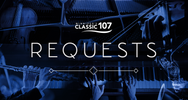Tune in every day @ 1PM for a complete piano trio by the iconic composer
It's in the piano trios that you'll find a more 'classical Beethoven'. This is partly because of the genre.
The piano trio genre was not the place Beethoven experimented or "went all out" - as he did in his symphonies, quartets and piano sonatas - but more a genre he wrote to sell music (although the empassioned C-minor trio of Opus 1 seems more written for Beethoven's own expression).
In the late 1700's, the piano trio was a popular combination for the home music market for many a Vieneese amatuer. Also, it was common and in demand for composers and publishers to transpose popular orchestral works down to the piano trio for this market of paying customers. What was also a trend then was including the themes of the latest "pop music" people were humming around town in theme & variation movements.
Surprisingly, some of Beethoven's finest piano trios are found in his Opus 1 set - the very first compositions Beethoven found worthy of publication. These were written in his early 20's and already show the musical skills and depth of a fully-mature composer. Highlights of these recordings are the attractive and musically-rich Opus 1 set mentioned, the magnificant opus 70 two trios, and the noble, heroic-period "Archduke Trio" - perhaps the most famous of them all.
Intermezzo host Chris Wolf has selected 5 piano trios--one for each day.
Monday: Piano Trio No. 1 Op. 1 in E-flat major (written for piano, violin and violincello)
While some members of the nobility kept full orchestras or opera companies on their estates, most were content with (or could afford only) much smaller ensembles. Prince Karl von Lichnowsky was among the latter, maintaining a string quartet to perform in his home. At one of Lichnowsky's weekly soirées Beethoven's three piano trios later published as Opus 1 received their first performance. The Op. 1 Trios were composed in 1794-1795, although some musicilogists have shown that the first of the set may have been written in Bonn and then revised in 1793.
In May 1795 Beethoven negotiated a contract with Artaria to have the trios published in Vienna and dedicated to Prince Lichnowsky, who secretly subsidized the printing. These were the first works to which Beethoven gave an opus number. Evidently, Beethoven planned to make the trios popular among connoisseurs through performances before publication in order to increase sales. This strategy worked, for advertisements attracted 123 subscribers, who requested 241 scores.
It was no accident that he chose the medium to announce himself to the wider musical world. The combination of violin, cello and piano was a favourite with amateurs. It assured Beethoven a star role on his own instrument. And unlike, say, the string quartet and the symphony, it had not been central to the output of Mozart or of Haydn, whose wonderful series of late trios was introduced to Vienna only after his return from London in August 1795.
The first two movements of the E flat major Trio, No 1, are the most obviously Mozartian in the set, though the opening Allegro’s textural richness, thematic abundance and sheer breadth of scale are hallmarks of the young Beethoven.
Interesting Fact:
Despite the Op. 1 designation these were not Beethoven's first published compositions; this distinction belongs to his Dressler Variations for keyboard (WoO 63).
Source: https://en.wikipedia.org/wiki/Piano_Trios,_Op._1_(Beethoven)
Tuesday: Symphony No. 2 in D Major, Op 36 (Arranged for piano trio)
Most people are now accustomed to the idea that if you want to hear a certain piece of music, it's just a click away on your iPod, or downloadable from the internet. But of course, not so long ago, people couldn't hear music unless they played it themselves. Opportunities to hear large-scale music live were very limited - this was before the days of jet-setting orchestras and the professional concert circuit, and a new orchestral piece might be played in your town only once. So there was a thriving market in more modest arrangements of these new orchestral pieces, to enable music-lovers to tackle them at home.
Beethoven's own trio version of his Second Symphony first appeared three years after the orchestral original. As the first reviewer wrote in 1806: "It is for those who through recollection want to repeat the pleasure of the complete performance, and look over and examine more calmly whatever was not entirely clear or particularly to their liking."
Sometimes, as in this case, the composer himself made the arrangement. But, unhampered by copyright restrictions, publishers often commissioned other musicians to arrange popular works, with or without the consent of the composer. Johann Peter Salomon made delightful arrangements of Haydn's "London" Symphonies for chamber group; Chopin's Piano Concertos were published with the wind parts cued into the string parts for chamber performance. Many symphonies, such as those of Brahms, were arranged for piano duet, sometimes for piano solo. Great composers were usually very pragmatic and flexible, naturally preferring a small-scale performance to none at all, and often happily taking part in such performances themselves.
There are other advantages to playing this version of the Second. Orchestral musicians may have their own views on how a work should be played, but they must submit to the conductor's authority. Most chamber musicians, however, are attracted to their field because they know their views will be instrumental in guiding the result. They like the idea of working without a conductor: holding the outcome entirely in your hands can be liberating.
What about the audience? How will this miniature version of a much-loved orchestral work sound to you? Will you miss the brass in the climaxes, or the woodwind solos, now transferred to other instruments? The entire symphony, half an hour long, has been faithfully transcribed for trio, note by note. Will it seem too long when played by just the three? Tune in Tuesday @ 1PM to find out!
Source: https://www.theguardian.com/music/2009/jun/05/florestan-trio-beethoven-second
Wednesday: Trio in E flat, Op. 38
This trio, like Tuesday's trio, is a 1805 arrangement of the earlier Septet in E flat, Op. 20 by Ludwig van Beethoven. The original piece, completed in 1800, was scored for clarinet, horn, bassoon, violin, viola, cello and double bass. This version was rewritten for clarinet (or violin), cello, and piano. The overall layout of the work resembles a serenade, closely mimicking Mozart's K. 563 trio, but enjoying substantial additions.
Thursday: Trio in D Major, Op. 70, No. 1, “Ghost”
Beethoven's most famous piano student, the composer Carl Czerny, wrote in 1842 that the second movement of the Piano Trio in D, the Largo assai, reminded him of the ghost of Hamlet's father. He was close; evidence from pages of Beethoven's notebook suggests that the composer was discussing an opera of Shakespeare's Macbeth with the playwright Heinrich von Collin at the time. The words "Macbett" and "Ende" appear near sketches for the Largo. The "Ghost" movement was possibly meant for a scene of the three Witches. Czerny's nickname stuck; today the work is known as the "Ghost" Trio.
That middle movement is introduced with an eerie, sustained three notes in the strings, after which the piano responds mournfully. The strings and piano alternate this way through the introduction, thereby setting the ominous mood of the Largo. The dark D-minor melodies of the exposition become more forceful in its repeat. As the development begins, Beethoven modulates briefly to C major, then quickly moves on through several keys to re-establish the tense atmosphere. The end of the movement is characterized by gripping pauses and abrupt and intermittent stops and outbursts. With all its ghostly qualities, the movement's effects are achieved quite simply, with slow crescendos and diminuendos, chromaticism and silences, as well as impressionistic use of tremolando.
To set off the "Ghost" movement further, Beethoven made the outside movements shorter (each about six minutes long) and much more direct in style, giving the whole trio an arched shape. The first movement begins with a fast-moving rhythmic figure played in a vigorous unison; the main thematic material of the movement is played within the first several bars. The third movement, after the disturbance or even near-upheaval the listener has experienced in the center movement, is a return to more lucid writing, and serves as bright, warm relief. The music leaves out the sharp contrasts of both preceding movements, and instead flows serenely and seamlessly to the end.
Although Beethoven never actually abandoned the Classical harmonic language, the works of his second ("middle") period, including the "Ghost" Trio, gradually moved away from Classical models in terms of their length and intensity, as well as in their innovation. In addition, the music became increasingly difficult for even the top players of the time. The middle period, lasting roughly from 1802 to 1812, began as Beethoven was coming to grips with his emerging deafness during a six-month stay under doctor's orders in the village of Heiligenstadt, outside Vienna. The outcome of this was, of course, not a cure for his deafness but the composer's resolution of the crisis as laid out in the famous Heiligenstadt Testament. This letter, addressed to his two brothers, and found only after the composer's death, admits the extent of his hearing loss, and the resulting fear and shame Beethoven suffered. The music written during these years is notable, not surprisingly, for its expression of heroism and struggle, as well as its monumental scale. The Op. 70 Trios, written in Heiligenstadt in 1808, fall between the Fifth and Sixth symphonies and the Seventh and Eighth. As every one of those symphonies raised the bar, so scholar Lewis Lockwood says of the "Ghost" Trio: "(it) raises the genre to a level from which the later piano trio literature could move forward." By the end of Beethoven's second period, he was conceiving chamber music on an even more symphonic scale.
- Jessie Rothwell is the Publications Coordinator for the Los Angeles Philharmonic.
Source: http://www.laphil.com/philpedia/music/trio-d-major-op-70-no-1-ghost-ludwig-van-beethoven
Friday: Piano Trio Op. 97 (The Archduke)
Considered by many to be Beethoven's most beautiful Piano Trio, Archduke Trio marked a turning point in the composer's performing public life.
The most beautiful of all Beethoven’s Piano Trios, and one that holds a poignant place in his life. At its first public performance Beethoven insisted on playing the piano part, although his hearing was now (1814) seriously defective. The composer and violinist Louis Spohr reported:
It was not a good performance. In the first place the piano was badly out of tune, which was of little concern to Beethoven because he could not hear it. Secondly, on account of his deafness, there was scarcely anything left of the virtuosity of the artist which had formerly been so greatly admired. In forte passages the poor deaf man pounded on the keys till the strings jangled, and in piano he played so softly that whole groups of notes were omitted, so that the music was unintelligible. I was deeply saddened at so harsh a fate. It is a great misfortune for anyone to be deaf, but how can a musician endure it without giving way to despair? From now on Beethoven’s continual melancholy was no longer a riddle to me.
Beethoven knew it too. Apart from one more performance a few weeks later, he never performed in public again. Listen to the glorious slow movement of the Archduke Trio knowing that, and it will carry a whole new meaning.







